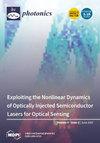An Adjustment Strategy for Tilted Moiré Fringes via Deep Q-Network
IF 2.1
4区 物理与天体物理
Q2 OPTICS
引用次数: 0
Abstract
Overlay accuracy, one of the three fundamental indicators of lithography, is directly influenced by alignment precision. During the alignment process based on the Moiré fringe method, a slight angular misalignment between the mask and wafer will cause the Moiré fringes to tilt, thereby affecting the alignment accuracy. This paper proposes a leveling strategy based on the DQN (Deep Q-Network) algorithm. This strategy involves using four consecutive frames of wafer tilt images as the input values for a convolutional neural network (CNN), which serves as the environment model. The environment model is divided into two groups: the horizontal plane tilt environment model and the vertical plane tilt environment model. After convolution through the CNN and training with the pooling operation, the Q-value consisting of n discrete actions is output. In the DQN algorithm, the main contributions of this paper lie in three points: the adaptive application of environmental model input, parameter optimization of the loss function, and the possibility of application in the actual environment to provide some ideas. The environment model input interface can be applied to different tilt models and more complex scenes. The optimization of the loss function can match the leveling of different tilt models. Considering the application of this strategy in actual scenarios, motion calibration and detection between the mask and the wafer provide some ideas. To verify the reliability of the algorithm, simulations were conducted to generate tilted Moiré fringes resulting from tilt angles of the wafer plate, and the phase of the tilted Moiré fringes was subsequently calculated. The angle of the wafer was automatically adjusted using the DQN algorithm, and then various angles were measured. Repeated measurements were also conducted at the same angle. The angle deviation accuracy of the horizontal plane tilt environment model reached 0.0011 degrees, and the accuracy of repeated measurements reached 0.00025 degrees. The angle deviation accuracy of the vertical plane tilt environment model reached 0.0043 degrees, and repeated measurements achieved a precision of 0.00027 degrees. Moreover, in practical applications, it also provides corresponding ideas to ensure the determination of the relative position between the mask and wafer and the detection of movement, offering the potential for its application in the industry.通过深度 Q 网络实现倾斜莫伊里叶的调整策略
叠层精度是光刻技术的三大基本指标之一,直接受到对准精度的影响。在基于 Moiré fringe 方法的对准过程中,掩膜和晶片之间的轻微角度偏差会导致 Moiré fringe 倾斜,从而影响对准精度。本文提出了一种基于 DQN(深度 Q 网络)算法的校准策略。该策略包括将连续四帧的晶片倾斜图像作为卷积神经网络(CNN)的输入值,并将其作为环境模型。环境模型分为两组:水平面倾斜环境模型和垂直面倾斜环境模型。通过 CNN 进行卷积和池化运算训练后,输出由 n 个离散动作组成的 Q 值。在 DQN 算法中,本文的主要贡献在于三点:环境模型输入的自适应应用、损失函数的参数优化以及在实际环境中应用的可能性,从而提供一些思路。环境模型输入接口可应用于不同的倾斜模型和更复杂的场景。损失函数的优化可以匹配不同倾斜模型的平整度。考虑到这一策略在实际场景中的应用,掩膜和晶片之间的运动校准和检测提供了一些思路。为了验证该算法的可靠性,我们进行了模拟,生成了因晶圆板倾斜角度而产生的倾斜莫伊雷条纹,随后计算了倾斜莫伊雷条纹的相位。使用 DQN 算法自动调整晶片的角度,然后测量各种角度。在同一角度下还进行了重复测量。水平面倾斜环境模型的角度偏差精度达到 0.0011 度,重复测量的精度达到 0.00025 度。垂直面倾斜环境模型的角度偏差精度达到 0.0043 度,重复测量的精度达到 0.00027 度。此外,在实际应用中,它还为确保确定掩膜和晶片之间的相对位置以及检测移动提供了相应的思路,为其在工业中的应用提供了可能。
本文章由计算机程序翻译,如有差异,请以英文原文为准。
求助全文
约1分钟内获得全文
求助全文
来源期刊

Photonics
Physics and Astronomy-Instrumentation
CiteScore
2.60
自引率
20.80%
发文量
817
审稿时长
8 weeks
期刊介绍:
Photonics (ISSN 2304-6732) aims at a fast turn around time for peer-reviewing manuscripts and producing accepted articles. The online-only and open access nature of the journal will allow for a speedy and wide circulation of your research as well as review articles. We aim at establishing Photonics as a leading venue for publishing high impact fundamental research but also applications of optics and photonics. The journal particularly welcomes both theoretical (simulation) and experimental research. Our aim is to encourage scientists to publish their experimental and theoretical results in as much detail as possible. There is no restriction on the length of the papers. The full experimental details must be provided so that the results can be reproduced. Electronic files and software regarding the full details of the calculation and experimental procedure, if unable to be published in a normal way, can be deposited as supplementary material.
 求助内容:
求助内容: 应助结果提醒方式:
应助结果提醒方式:


